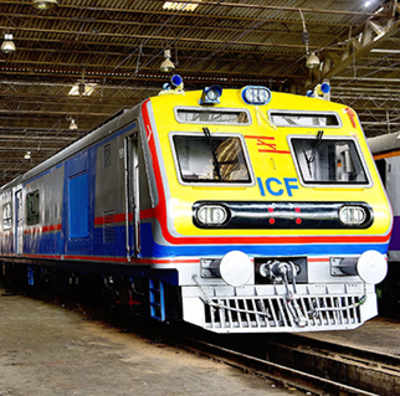Track trials of AC local set to start Tuesday

The 12-coach AC rake, which arrived on April 5, will run between Karjat and Khopoli with gunny bags mimicking peak and non-peak passenger loads.
Track trials of Mumbai’s muchawaited first AC local are set to start on Tuesday, ending months of wait and spurring hopes of a more comfortable ride soon on the suburban network.
The 12-coach AC rake, which has been parked at the Kurla car-shed since April 5, when it arrived from the Integral Coach Factory in Chennai, will run between Karjat and Khopoli with gunny bags mimicking peak and non-peak passenger loads.
The introduction of AC locals has faced several problems mainly involving its height, which is more than the trains running currently on both the Central and Western lines. In fact, to run the AC local, the railways may have to lift some of the old bridges between Kurla and CST or demolish them.
General Manager, Central Railway, D K Sharma, who joined office on November 30, said to have the AC local up and running as soon as possible is going to be his main focus. Sharma, who is one of the senior-most electrical engineers in the railways, described the height problem as something not unsurmountable. “We have started working on it alongside the track trials for the AC train. Hopefully, we will be able to resolve all issues soon,” he said. Divisional Railway Manager, Central Railway, Ravinder Goyal, who is directly overseeing the trials, said the first of track trials will last two weeks. He, however, said it would be difficult to predict at this point the exact date when the AC local will be commissioned.
The AC rake, which cost the railways nearly Rs 55 crore, can seat 1,028 commuters and carry close to 6,000, including standees. Like the Metro, it allows commuters to walk from one coach to the next through vestibules. It has two sets of inter-connected bogies, each comprising six coaches.
Track trials of Mumbai’s muchawaited first AC local are set to start on Tuesday, ending months of wait and spurring hopes of a more comfortable ride soon on the suburban network.
The 12-coach AC rake, which has been parked at the Kurla car-shed since April 5, when it arrived from the Integral Coach Factory in Chennai, will run between Karjat and Khopoli with gunny bags mimicking peak and non-peak passenger loads.
The AC rake has already undergone a series of static trials at the Kurla carshed. These tests essentially refer to a range of tests performed on the train without making it move. Track trials, or dynamic trials, however, are the most important because these are the real test of rake’s quality and stability.
The introduction of AC locals has faced several problems mainly involving its height, which is more than the trains running currently on both the Central and Western lines. In fact, to run the AC local, the railways may have to lift some of the old bridges between Kurla and CST or demolish them.
General Manager, Central Railway, D K Sharma, who joined office on November 30, said to have the AC local up and running as soon as possible is going to be his main focus. Sharma, who is one of the senior-most electrical engineers in the railways, described the height problem as something not unsurmountable. “We have started working on it alongside the track trials for the AC train. Hopefully, we will be able to resolve all issues soon,” he said. Divisional Railway Manager, Central Railway, Ravinder Goyal, who is directly overseeing the trials, said the first of track trials will last two weeks. He, however, said it would be difficult to predict at this point the exact date when the AC local will be commissioned.
The AC rake, which cost the railways nearly Rs 55 crore, can seat 1,028 commuters and carry close to 6,000, including standees. Like the Metro, it allows commuters to walk from one coach to the next through vestibules. It has two sets of inter-connected bogies, each comprising six coaches.
GALLERIES View more photos











